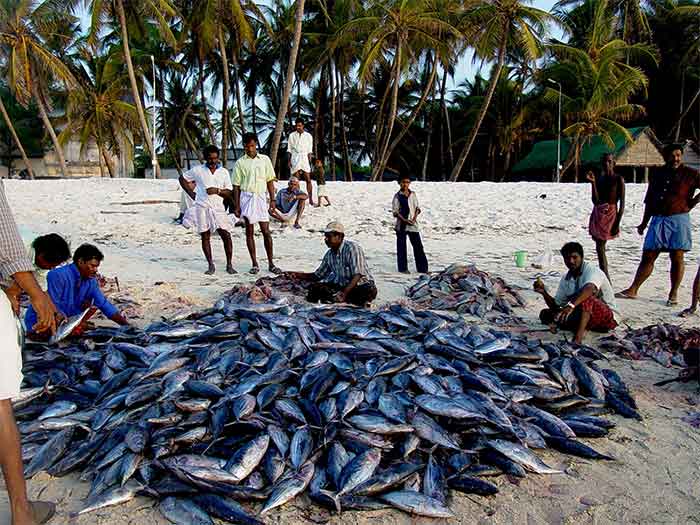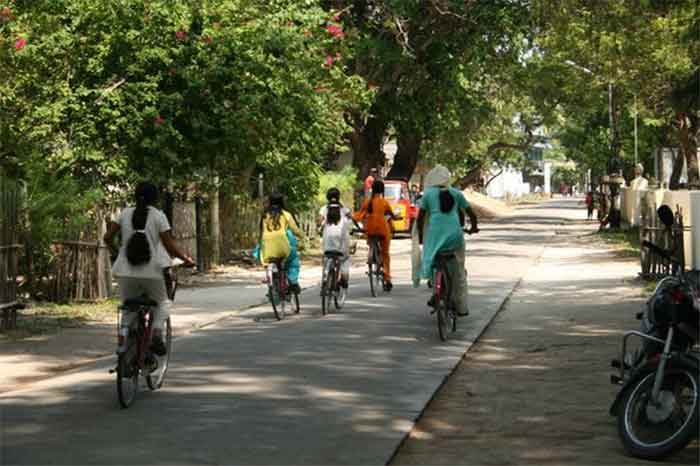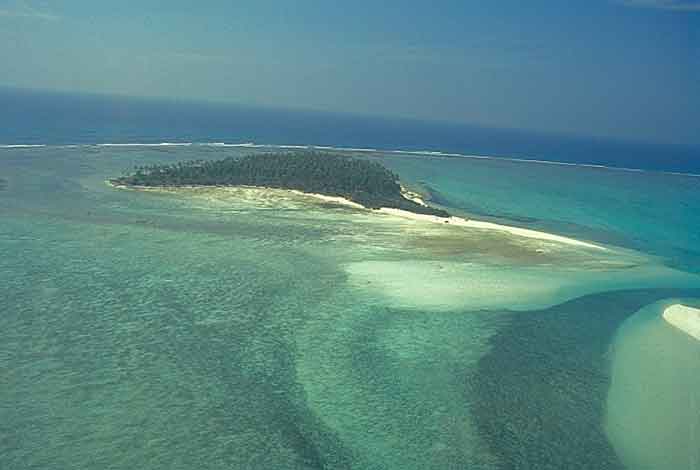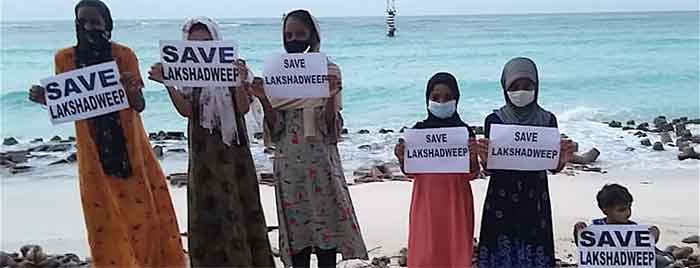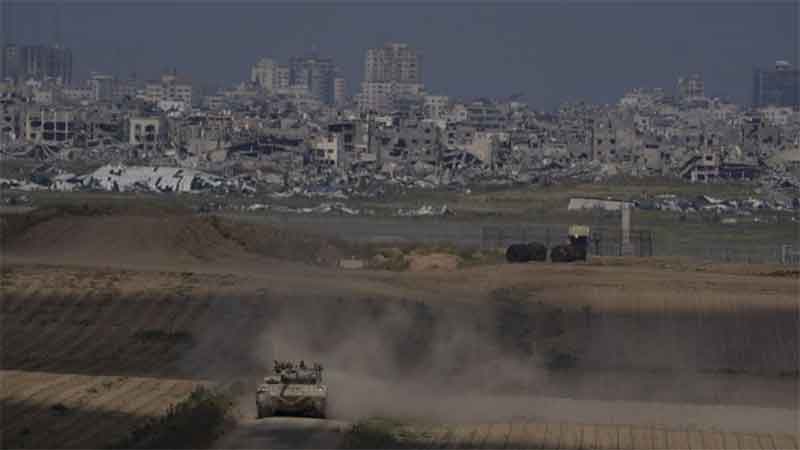
A number of articles and series of news stories have already appeared in the mainstream media regarding the exceptionally illogical, and troubling new rules and regulations of the recently appointed administrator of Lakshadweep, Praful Khoda Patel, who served earlier as a home minister in the Narendra Modi-led Gujarat government. The actions taken by the new administration received much attention in a sense, the proposed action plan will eventually destroy the unique culture of Lakshadweep and seriously curtail their rights. Those articles and reports are rich enough in explaining (and expressing solidarity) both the cultural and human rights issues that are going to unfold. However, the ecological and environmental impacts of the new action plan are less covered. Environment and ecology have a significant importance while we talk about a geographical landscape, because its deterioration will put in peril the lives of people living there and cut them away from their cultural roots. As a student interested in ecology, this article is an attempt to bring forth the ecological and environmental disasters that await over a fragile ecosystem.
Peculiarities and threats
Lakshadweep, is a small archipelago in the Arabian Sea comprising 36 islands with unique culture and biodiversity. From the 36 islands, 10 islands are inhabited (Agatti, Amini, Androth, Bitra, Chetlat, Kadmat, Kalpeni, Kavaratti, Kiltan and Minicoy) and Bangaram Island has a tourist resort . Lakshadweep islands are the only atoll islands in India, which are ring- shaped coral reefs including a coral rim that encircles a lagoon partially or completely and with or without a coral island/cays on the rim. The atolls have 4 distinct biomes comprising the islands, lagoons, reefs and the Open Ocean. Although the land area is extremely small (32 km2), Lakshadweep islands are bestowed with a large lagoon area of 4200 km2, which is the basis of the physical existence of islands. Within this lagoon, land area, the territorial water area (20000 km2) and in the exclusive economic zone (40000 km2), lies the coral reef and seagrass species that serves as the foraging, breeding and resting habitat for a range of marine fauna. Reefs are considered to be the centres of high biological productivity, CO2 sinks and rich in biodiversity. They are a source of calcium carbonate deposit and aid in shoreline protection. Coral reefs can also serve as the indicators of potentially catastrophic consequences on natural communities as well as human societies. These coral reef systems and the surrounding biota are the backbone of the livelihood of Lakshadweep people, which are at a high risk at present.
The coral reefs of the world are deteriorating vastly. Pollution, habitat destruction, and several anthropogenic and natural pressures triggers the mass bleaching and outbreak of diseases are the main causes of this reduction. Lakshadweep experienced 3 El Nino southern oscillations, (ENSO) events, and coral mortality rates were reported in 1998(80%) 2010(44%), and 2016(31%). Although coral reefs in Lakshadweep islands showed a remarkable ability to regenerate after these events, several other fauna, which are mediating communities and keystone species in the reefs, were severely outnumbered. It is expected that 32 per cent of the reefs may be lost in the next 30 years if the threats are not reduced (1). Loss of healthy coral reefs will lead to elimination of primary sources of food, income and employment for millions of people around the world, as well as the extinction of many fascinating and beautiful marine species. Some live corals are getting affected by crown of thorns (Acanthaster planci) infection. The live coral cover of the Lakshadweep Islands ranged between 17.5% and 44.3% during 2009 (2). The lowest percentage of live coral cover was recorded at Suheli Island and the highest percentage at Bitra Island.
The biodiversity of Lakshadweep island were estimated by several researchers and the Corals are represented by 148 species; fish-126 families and 601 species; crustaceans-68 species; mollusks-227 species; sponges-91 species; mangroves-2 species; seaweeds-114 species; echinoderms-78 species, seagrass-6 species; sea turtles-4 species; 101 species of birds and 12 species of cetaceans,248 species of plants etc. Pitti Island, a sand bank situated nearly 24km northwest of Kavaratti with an area of only 1.21 ha, is an island of birds and declared as a bird sanctuary (3). This is a breeding ground for 4 species of terns and therefore the island has great significance since such breeding colonies are very rare in the Indian territorial areas. Most of these organisms are irreplaceable chains in the web of ecological balance and are providing significant roles in ecosystem functioning. Sea grasses are important in preventing the sea erosion and movement of beach sediments. Sea cucumbers, on the other hand, one of the most valuable species from the Lakshadweep islands, are important in nutrient cycling and enjoy the same status as tigers and lions As per Schedule I of Wildlife Protection Act. Schedule 1 stands for absolute protection and offences under it invite the highest penalties. It was in this context that the Lakshadweep administration announced the creation of the world’s first conservation area for endangered sea cucumbers in an area spread in 239 sq. km. (4) even though sea cucumbers, blue whales, dolphins and turtles are protected under schedule 1, they are the most exploited species and this fragile coral ecosystem is deteriorating due to many natural and manmade causes.
It is imperative that, apart from the current plans of extensive tourism, conservation measures be urgently implemented in some of these islands to preserve and protect these habitats for scientific, cultural and economic purposes. The new administrator claims that this plans are made up for the future of the islands along the “developmental lines of Maldives” which is against the wishes of local people as well as the previous action plans for Lakshadweep islands. The coral islands and lagoons are home to a variety of threatened and endangered species which will possibly attract more tourists by the upcoming projects, but the ecological impacts on these fragile ecosystems cannot be determined easily. Because, Lakshadweep is already suffering from several anthropogenic threats, by dredging of the reef to create wider entry points for navigation, collection of corals and shingles from the reef for construction activities, overexploitation of certain resources (movement of human beings in the reef for gleaning, dragging fishing nets and the drop in the number of live-bait fishes),Oil spills, sewage, presence of synthetic products such as rubber, plastics, cements and heavy metal pollution which likely to have an adverse effect on corals that will ultimately affect many other reef organisms, which rely on these healthy communities either directly or indirectly.
The research of Rohan Arthur and colleagues (5) showed the reefs in Lakshadweep islands are eroding faster than they are accreting, and the trends shows that, most of the islands will experience increasing land erosion, shortage of fresh water stocks, and increased damage on every major cyclones or climatic events in the following decades. This implies the prime importance to climate resilience while dealing with each and every developmental or tourism projects of Lakshadweep islands and for the better implementation they should be more transparent and should be with the involvement of both the government and civil society. The action plan of Lakshadweep in 2012 (6) acknowledged the reality of climate change and listed out the consequences of extensive tourism, developmental projects and other exploitation project, even though the proposed strategies were not enough to deal with the current problems. But the current draft of Lakshadweep development authority regulation 2021, is far away from the ecological and climate change concerns and more focused on the developmental infrastructure, good governance, and sound planning. The proposed regulation looks to centralise all the decisions about the land and property which can determine the future projects within the land. This reinforces the domination of administration over the island and its inhabitants. The new regulation diluted most of the unambiguous recommendations provided by the report of justice Raveendran committee (2014), appointed to evaluate the draft IIMP (Integrated Island Management Plan) received from National Centre for Earth Science Studies (NCESS). The report warned to consider the ecological fragility, and the essentiality of protecting corals, sea grass and other ecosystems from anthropogenic activities while considering developmental projects and are now diluted by the recent NITI Ayog plans for the new projects of Lakshadweep.
The developmental projects and new tourism plans are highlighted as a win-win for the stakeholders and local people. But Threats to Lakshadweep and its people from these so-called “holistic island development” plans are clear, and the people are afraid of influential corporates descending on the Lakshadweep islands and ruining their culture and livelihoods. Islanders fish in the lagoons for their daily consumption. Lagoon fish are also the backbone of Lakshadweep’s famous sustainable and indigenous tuna fishery industry. And the beaches are heavily used: catch is processed and sundried on these sands. With tourism, and the spatial restrictions it could bring, locals fear that they will not be able to use the beaches or lagoons for their traditional livelihoods. Together, these assign unquestionable authority to the Administrator, including giving him total eminent domain powers over the territory and people of the Islands, enabling the administration to take over any part of the islands in the name of “development activities”, including ecologically damaging mining and extraction of mineral resources; to forcibly remove or relocate any islander owning that land, despite the fact that over 95% of islanders belong to Scheduled Tribes whose lands cannot be easily alienated; to bypass Panchayats and other local government bodies; and, amazingly, placing any such actions by the Administrator beyond appeal or judicial review.
The scope of tourism developments by trading the natural beauty of Lakshadweep islands are long discussed by most of the governments and the Narendra Modi government showed a special interest in improving tourism facilities in islands. In January 2020, India’s Home Minister Amit Shah, chaired a meeting of the Island Development Agency, wherein the government reviewed the progress made towards the development of islands. The meeting produced an official statement about the land based and water villa projects for inviting the participation of the private sector. The proposed projects include the first ever water villa projects in the Indian ocean islands, scuba diving and other water sports, eco-tourism under NITI Ayog, promotion of seaplane operation in Lakshadweep and cruise tourism in the islands. The government expects a large influx of tourists through the upcoming projects, but which may be greater than the carrying capacity of these small islands and the impacts on these ecological paradise will be overwhelming. The Lakshadweep action plan on climate change (2012) predicts the future pressures from the scarcity of fresh water, and the influence on the ground water resources, which will become a limiting factor for the survival of the inhabitants of the islands in the coming years. In the light of this evidence, any developmental or infrastructure development of these fragile and sensitive area require more imagination and climate resilient plans than the current plans. There are several data gaps to be addressed in order to develop strategies for adapting to climate change. The Lack of scientific knowledge and the data gap can also result in devising mal-adaptive strategies, under the climate change realm, which in turn can impact the fragile ecosystem.
Maldives model – a marker of disaster
Tourism in the Maldives exists solely due to the physical and geographic features of the coral islands exactly in the case of Lakshadweep. The beauty of the underwater world at the reefs, clean water in the lagoons, white and pristine sandy beaches, rich island vegetation and ideal tropical climate which form a virtual paradise that attracts tourists. According to the proposal of the NITI Ayog plan similar water villas to be constructed at Minicoy, Suheli and Kadmat islands of Lakshadweep and the government has already started inviting bids for more than six such ecotourism projects which will be based on public-private partnership model. Apart from the aesthetic similarity with Maldives, there are a number of limiting factors for the so-called tourism in Lakshadweep. Maldives consist of 1192 islands and most of them are uninhabited islands. The population density of Maldives is also nearly half of the Lakshadweep islands. Beyond that, the model of tourism was exclusively for the business interests and it will expel the local communities.
The other side of this ‘Maldivian model’ of tourism development merely considers the peripheral beauty and appearance only. But each island ecosystem is very unique in terms of biodiversity, physical environment and threats by natural and anthropogenic factors. Isolation of islands promotes high endemism and specialised flora and fauna and the majority of recorded extinctions have been in islands over the last 500 years (7). the Significant impacts noted from Maldives were the increased level of reef fishing to service the tourism industry, beach erosion, sewage disposal, groundwater depletion and threats by the solid waste with rising number of tourists will provide an insight to the similar state of Lakshadweep in the near future.
The administration solely shielded the impacts and warnings from experts just to launch the new plans and projects, by ruining the livelihood of local people as well as the ecosystem. This does not mean that the environment and natural resources should not be used for human progress. But the developmental projects should be participatory that includes the local knowledge, experience and address the requirements of the local community. Otherwise it will be ecologically disastrous and undemocratic.
- Laretta Burke, Kathylene Reytar, Mark Spalding, Allison Perry, Reefs at risk revisited (2011), World Resources Institute.
- Report on visit to Lakshadweep- a coral reef wetland included under national wetland conservation and management programme of the ministry of environment and forests, (2018)
- K Muhammad Koya and Abdul Azeez (2017), Fishing in atolls- trade-off between harvest and conservation, pelagic fisheries division, ICAR, central marine fisheries institute.
- Union territory of Lakshadweep administration, department of environment and forest, F.No.2/26/2020-E&F
- Rohan Arthur (2008) Patterns of benthic recovery in the Lakshadweep islands, coastal ocean research and development in the Indian Ocean state report.
- Lakshadweep action plan on climate change (LAPCC) (2012), U.T of Lakshadweep
- John C. Briggs (2017), Emergence of sixth mass extinction, Biological journal of Linnean society.
Sadiya Sherin C.T., Research Scholar, Dpt. Of Ecology and Environmental Science, Pondicherry University. I am currently working on forest ecology. As a scholar, published articles on ecology and environmental politics in various web portals. [email protected]
GET COUNTERCURRENTS DAILY NEWSLETTER STRAIGHT TO YOUR INBOX

